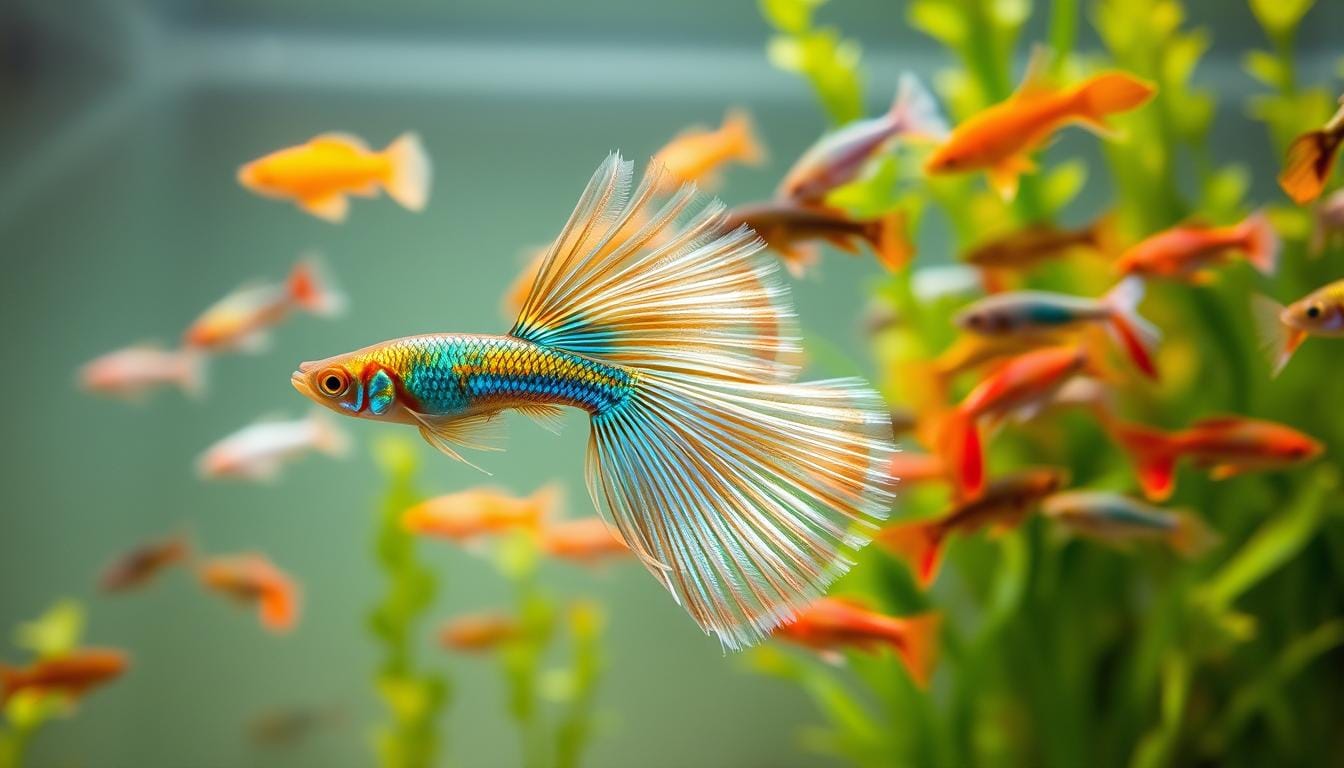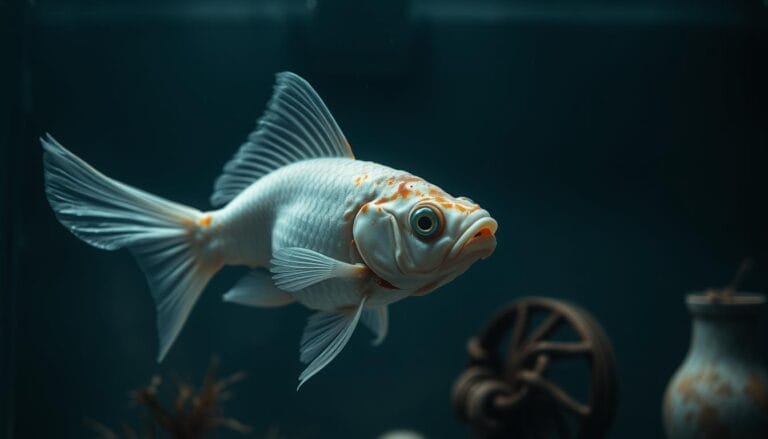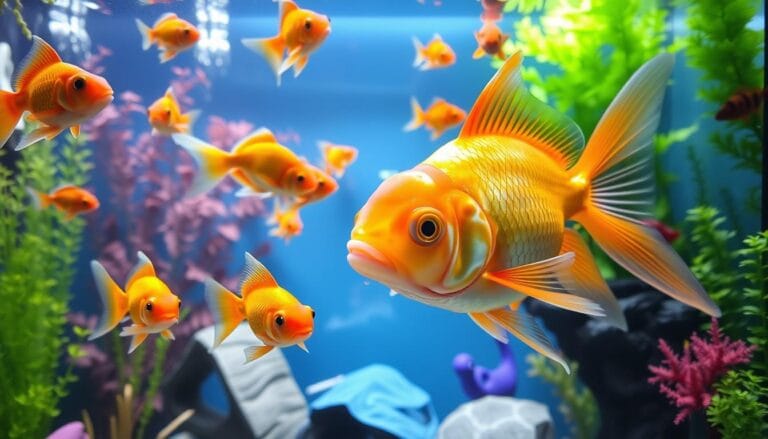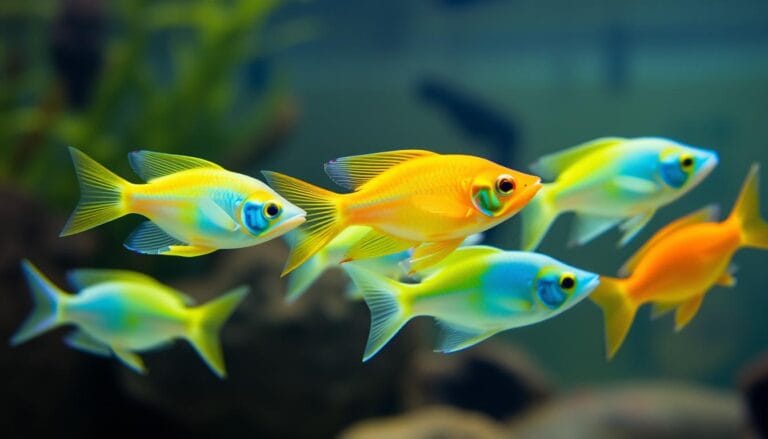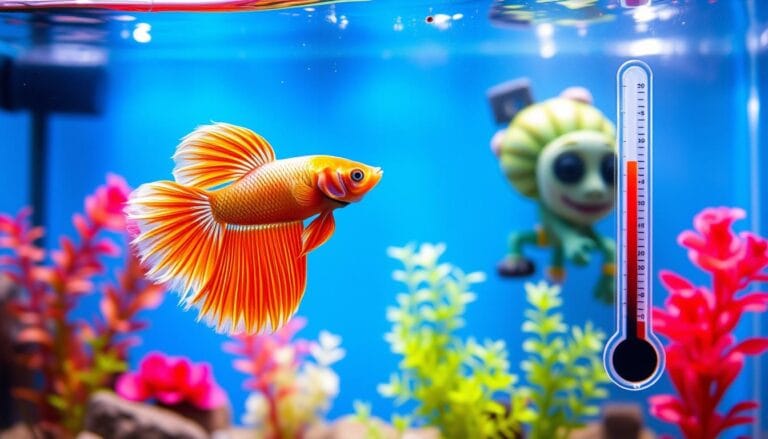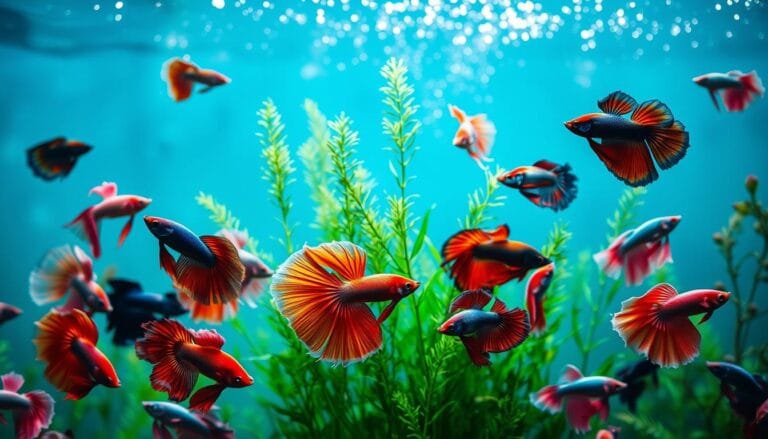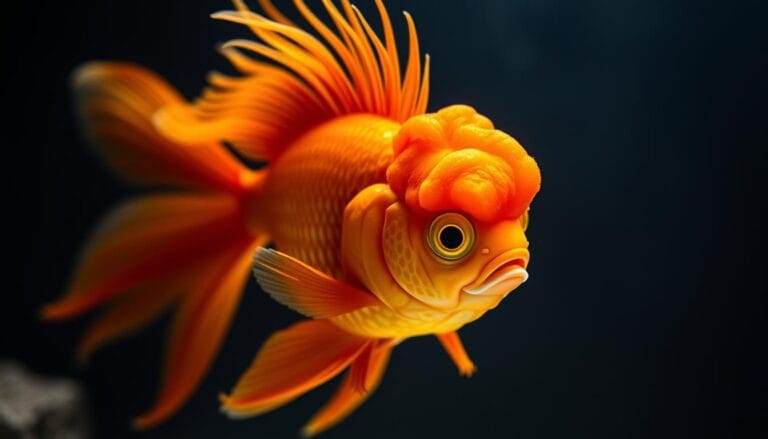How to Choose the Best Guppy Fish for Your Tank
We’re excited to help you pick the perfect guppy fish for your tank. Guppy fish are loved for their bright colors and fun personalities. They come in many colors like black, red, and green, making them a great choice for any tank.
Choosing the right guppy fish can be tough, with so many fancy guppies to choose from. Whether you’re new to aquariums or have experience, we’ll guide you through the key factors to consider.
Table of Contents
We’ll look at tank size, water conditions, and which fish go well together. By the end of this article, you’ll know how to pick the best guppy fish for your tank. Guppy fish are easy to care for and fun to watch, making them a great addition to any aquarium.
Key Takeaways
- Consider the variety of colors when choosing guppy fish, including black, red, orange, yellow, purple, blue, and green.
- Research the different types of fancy guppies to find the perfect fit for your tank.
- Ensure your tank is the right size for your guppy fish, with at least 2 gallons of water per fish.
- Choose tankmates that are compatible with guppy fish, such as non-aggressive small tropical fish.
- Provide a varied diet for your guppy fish, including high-quality flake or pellet food and live or frozen foods.
- Regularly test the water quality to ensure the health and well-being of your guppy fish.
- Consider the ideal water temperature range for guppy fish, which is between 74-82°F (23-28°C).
Understanding the Fascinating World of Guppy Fish
Guppy fish have a rich history. Knowing where they come from helps us care for them better. They come from South America and were brought to the pet trade. Now, they show off many colors and patterns, making them a favorite among aquarium lovers.
Exploring guppies means looking at their natural behavior and how it affects their care. They are easy to care for and great for beginners. To keep them happy, we need to mimic their natural home. This includes lots of plants, space to swim, and a balanced diet.
Healthy guppies are known for their bright colors, active swimming, and strong bodies. By understanding these traits and caring for them right, we can help them thrive. Whether you’re new to aquariums or experienced, learning about guppies is rewarding.
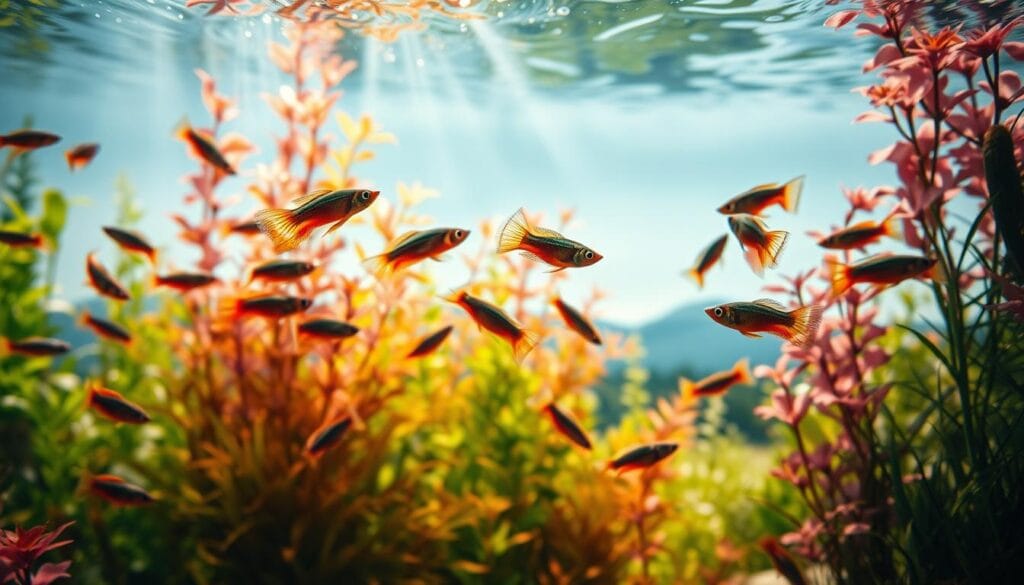
As we dive deeper into guppies, we’ll learn more about their interesting behavior, social lives, and breeding. With the right care, we can make a great home for our guppy friends.
Popular Types of Fancy Guppies
We’re excited to dive into the world of fancy guppies. These colorful fish have become a favorite in many aquariums. With nearly 300 varieties, they’ve won the hearts of many.
From the bright neon guppies to the graceful albino guppies, each variety has its own charm. They all have unique features that make them stand out.
Some popular fancy guppies include:
- Snakeskin guppies, known for their distinctive scale pattern
- Cobra guppies, recognized by their vibrant colors and detailed markings
- Delta-tail guppies, with their triangular-shaped tail fin
- Veiltail guppies, featuring long, flowing fins
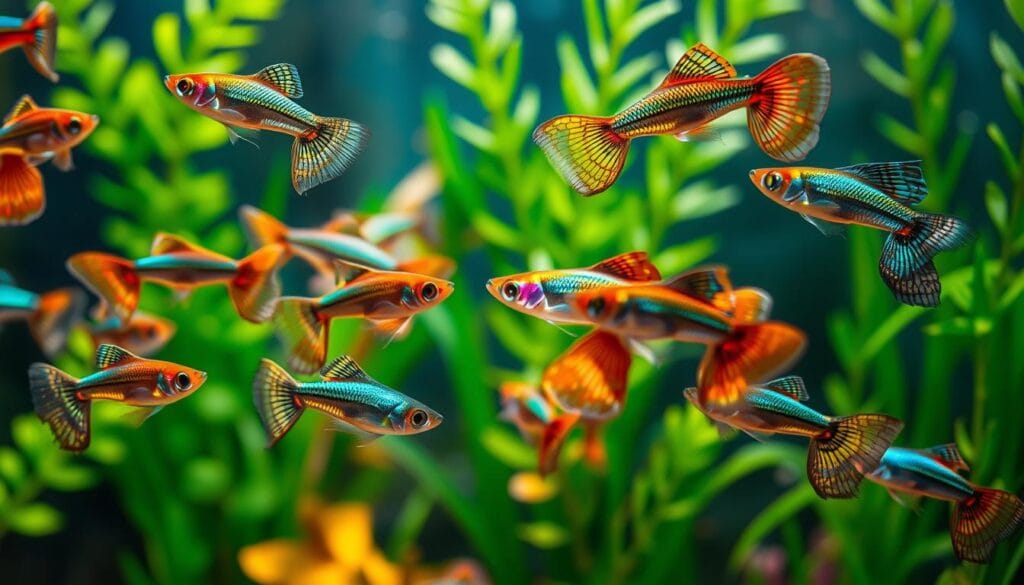
Fancy guppies offer endless possibilities. Whether you’re new to aquariums or experienced, they bring joy and excitement. With the right care, guppy fish can live happily, entertaining you for years.
Essential Tank Requirements for Guppy Fish
Creating a comfy and safe home for your guppy fish is key. We suggest a tank of at least 5 gallons with a tight-fitting lid to stop them from jumping. Guppies do best in water with a pH of 7.0 or higher and a temperature of 76-78°F. Keeping the water clean and using good filters is also vital for their health.
The guppy water temp greatly affects how long they live. At 76 to 78°F, they can live for 2 to 3 years. But, if the water is too warm at 82°F, their life shortens to about 18 months. On the other hand, cooler water at 72°F can make them live up to 3.5 years or more. Remember, how long does guppy fish live also depends on their food, where they live, and their health.
Here are some key tank requirements to keep in mind:
- Tank size: 5 gallons minimum
- Water parameters: pH 7.0 or greater, temperatures between 76-78°F
- Filtration: Regular water changes and proper filtration
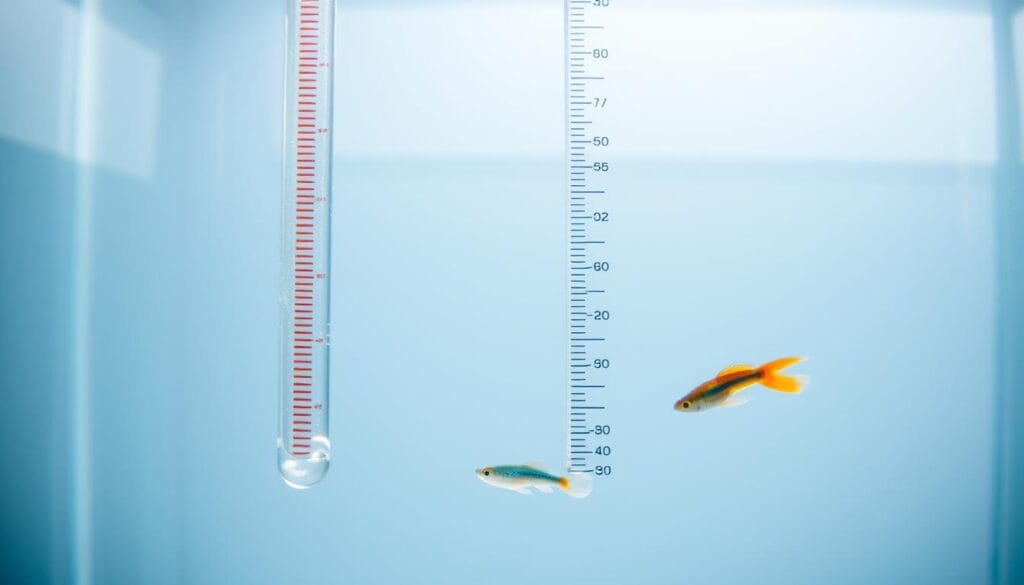
It’s not just about the tank size and water quality. You also need to think about how many guppies you have and how you feed them. A good rule is to have 2-3 females for every male to keep the females stress-free. Adults should eat once or twice a day, while baby guppies need to eat more often with smaller portions.
| Tank Size | Number of Guppies | Water Parameters |
|---|---|---|
| 5 gallons | 2-3 guppies | pH 7.0 or greater, temperatures between 76-78°F |
| 10 gallons | 4-6 guppies | pH 7.0 or greater, temperatures between 76-78°F |
By following these tips, you can make a great home for your guppy fish. Always do your research to understand their needs, including their diet and health, to help them live a long and happy life.
The Perfect Water Conditions for Guppies
For guppy care, the right water conditions are key. We suggest hard water with lots of calcium, magnesium, and other minerals. The best guppy water temp is between 76 to 78°F, perfect for their growth.
To get the water just right, you need to change the water often and check its quality. Make sure the pH is 7.0 or higher and the water is clean. Here are some important points to remember:
- Optimal pH levels: 7.0 or greater
- Ideal water temperature range: 76 to 78°F
- Regular water changes: essential for maintaining clean and fresh water
Keeping the water right helps prevent sickness and supports healthy growth. Guppies can get sick easily, so be careful when adding new fish to your tank.
Guppy care is about making a comfy and healthy home for your fish. Follow these tips and keep the water perfect. This way, your guppies will live long, happy lives. With the right guppy water temp and care, your aquarium will be a joy for years.
Identifying Healthy Guppy Fish Before Purchase
Choosing the right guppy fish, like fancy guppies, is key for your tank’s health. Look for fish with bright colors, active swimming, and a strong build. These signs show they are healthy.
A healthy guppy has clear eyes, full fins, and a strong body. Active swimming and being curious are also good signs. But, if a fish breathes hard, moves slowly, or looks sick, don’t buy it.
Physical Signs of Health
Here are some physical signs of health in guppy fish:
- Clear eyes
- Intact fins
- A sturdy body
- Vibrant colors
Behavioral Indicators
Healthy guppy fish also show certain behaviors:
- Active swimming
- Curiosity
- Responsive to their environment
Red Flags to Watch For
Be careful of these red flags when picking guppy fish:
- Labored breathing
- Lethargy
- Visible signs of disease
Knowing these signs helps you choose healthy guppy fish, including fancy guppies. This ensures your tank stays happy and healthy.
Male vs Female Guppies: Making the Right Choice
Choosing the right sex of guppy fish is key for guppy care, if you plan to breed them. Male guppies have a special organ called the gonapodium, which females lack. They also tend to be more colorful than females.
Females, on the other hand, can grow up to twice as long as males. They also have a more rounded body shape.
Some key differences between male and female guppies include:
- Male guppies have a tube-like anal fin, while females have a regular or triangular anal fin.
- Female guppies may exhibit a dark gravid spot near the anal fin, which is more pronounced when pregnant.
- Male guppies typically have longer fins than females, with variations including “veil tails” and “lyre tails.”
Knowing these differences is vital for guppy care. It helps you choose the right mix of male and female guppies. This way, you can create a peaceful environment and enjoy their vibrant colors.
Creating the Ideal Guppy Community
Creating a thriving guppy community involves several key factors. Guppies are social and do well in groups. They can live with peaceful fish like neon tetras and corydoras catfish. It’s important to pick tank mates that get along and keep the right gender balance.
It’s best to have one male for every two or three females. Introduce them all at once to avoid fights. This keeps the tank peaceful. Also, make sure the tank is big enough, with at least 2 gallons for each fish, for their health and growth.
Compatible Tank Mates
- Neon tetras
- Corydoras catfish
- Mollies
- Platies
Choosing the right tank mates and keeping the right gender balance is key. Make sure to feed them well with high-quality food and some live or frozen treats. This will keep your guppies healthy and happy.
Group Size Recommendations
A good rule is to have 6-10 guppies in your tank. This means 2-3 males and 4-6 females. This size group creates a balanced and colorful community. Following these tips will help your guppy community thrive and bring you joy for years.
Feeding Your Guppy Fish for Optimal Health
Understanding the diet of guppy fish is key to their health. In the wild, they eat algae, insect larvae, and small crustaceans. To mimic this, we should give them high-quality commercial foods with 40-50% protein.
Adult guppies need small portions of food two to three times a day. Each meal should last only two to three minutes.
Adding live or frozen foods one to two times a week is important. This includes brine shrimp and bloodworms. It’s vital to get these foods from trusted sources to avoid diseases.
Here are some key points to consider when feeding your guppy fish:
- Feed adult guppies two to three times a day, with each feeding lasting no more than two to three minutes.
- Supplement their diet with live or frozen foods one to two times per week.
- Introduce live foods from reliable sources to prevent disease or parasite introduction.
- Provide high-quality commercial foods with a protein content of approximately 40-50%.
By following these guidelines, we can ensure our guppy fish are healthy and happy. A balanced diet is a critical part of good guppy care.
Breeding Considerations for Guppy Owners
Guppy fish are known for their ability to breed quickly. They give birth to live young, which is different from laying eggs. This makes them popular among breeders. But, it also means they need special care to ensure their babies are healthy and colorful.
Genetic diversity is key when breeding guppies. Breeding too closely can lead to less desirable traits. To avoid this, breeders use techniques like linebreeding. This keeps the bloodline close but introduces new genetics to prevent health issues.
- Maintaining a balanced diet and proper water conditions, with a temperature range of 72°F to 78°F and a pH level between 7.0 to 8.0.
- Providing a secure and spacious breeding tank with plenty of hiding places.
- Understanding the genetics of color, finnage, and body shape to create a breeding program that produces healthy and vibrant offspring.
By focusing on these aspects and breeding responsibly, guppy owners can enjoy the joy of breeding these stunning fish. This is true for both fancy guppies and other varieties.
Common Health Issues and Prevention
Understanding common health issues in guppy fish is key to their care. Knowing these problems helps us prevent them. This way, our guppies can live happy, healthy lives. It’s important to watch our guppies for signs of illness and keep the water clean.
Diseases like White Spots (Ich), Fin Rot, Gill Flukes, and Dropsy can affect guppies. These issues often come from poor water quality or sudden changes. To avoid these, we must keep the water stable, change it regularly, and feed them well. Following good care practices can greatly reduce disease risk and keep our guppies thriving.
Here are some key preventive measures to keep in mind:
- Regular water changes of 10-25% every 2-4 weeks
- Monitoring water quality weekly for at least two months after introducing new fish or equipment
- Providing a balanced diet and avoiding overfeeding
- Maintaining consistent water temperature and pH
By knowing about these health issues and taking steps to prevent them, we can help our guppies live long, healthy lives. With the right care and attention, we can create a beautiful aquarium that brings joy and wonder to our lives.
| Disease | Symptoms | Prevention |
|---|---|---|
| White Spots (Ich) | Small white dots on skin and fins | Maintain consistent water temperature and pH, perform regular water changes |
| Fin Rot | Rotting fins or tails | Provide good water quality, avoid bacterial infections |
| Gill Flukes | Fish rubbing their gills against surfaces, gasping for air | Maintain good water quality, perform regular water changes |
Lifespan and Long-term Care Commitment
Thinking about getting guppy fish or fancy guppies? It’s a big deal. They can live up to 3-5 years with the right care. This means we need to keep their tank clean, change the water often, and feed them well.
Here are some key factors to consider when caring for your guppy fish:
- Water temperature: 64°F to 84°F, with mid-70s being ideal
- pH level: between 7.5 and 8.0
- Water hardness: 8 to 12 dGH
By caring for our guppies long-term, we get to enjoy their beauty and company for years. Guppies breed fast, which is why there are over 300 varieties. With the right care, they can live happily in our tanks for a long time.
In comparison to other aquarium fish, guppies live an average amount of time. Here’s a table comparing the lifespans of different fish species:
| Fish Species | Lifespan |
|---|---|
| Guppy Fish | 3-5 years |
| Fancy Guppies | 3-5 years |
| Goldfish | 10-15 years |
| Koi Fish | 25-35 years |
Knowing how long guppies live and what they need helps us give them the best life. This way, we can make sure they thrive in our aquariums.
Conclusion: Making Your Final Guppy Selection
Exploring the world of guppy fish has shown us their beauty and how they can brighten our lives. With over 300 species and more than 55 types, creating a unique guppy community is easy. These colorful fish can make any aquarium special.
Fancy guppies are perfect for both new and experienced fish keepers. Knowing about tank size, water quality, and tankmates is key. Guppies adapt fast and can quickly become the stars of your aquarium.
As we end our journey with guppy fish, we invite you to enjoy their beauty. This guide has given you the knowledge to choose the right guppy for you. Start your adventure, care for your guppies, and watch as they transform your aquarium into a stunning underwater world.
FAQ
What are the origins and natural habitat of guppy fish?
Guppy fish come from South America. They have been introduced to the pet trade. There, they have been bred to show many colors and patterns.
What makes guppies perfect pets?
Guppies are great pets because they are small, peaceful, and easy to care for. They don’t need much to be happy.
What are the characteristics of healthy guppy fish?
Healthy guppies have bright colors, swim well, and are strong.
What are the different types of fancy guppies?
Fancy guppies come in many colors and patterns. Examples include neon and albino guppies. Each type has its own look and traits.
What is the recommended minimum tank size for guppy fish?
Guppies need a tank of at least 5 gallons. Make sure it has a secure lid to stop them from jumping.
What are the ideal water parameters for guppy fish?
Guppies like hard water with a pH of 7.0 or higher. They prefer temperatures between 76-78°F. Regular water changes and good filtration are key.
How can I identify healthy guppy fish before purchase?
Look for clear eyes, intact fins, and a strong body. Also, check if they swim well and seem curious.
What are the differences between male and female guppy fish?
Males are more colorful and have a special fin called a gonopodium. Females are bigger and have a fan-shaped fin.
What are the ideal tank mates and community setup for guppy-fish?
Guppies do well with peaceful fish like neon tetras and corydoras catfish. Keep one male with two or three females.
What should I feed my guppy-fish?
Guppies eat a mix of flake or pellet food and live or frozen foods. Include brine shrimp and bloodworms in their diet.
What factors should I consider when breeding guppy-fish?
Breeding guppies needs a separate tank, hiding spots, and knowledge of genetics. This ensures healthy offspring.
What are the common health issues in guppy-fish?
Guppies can get diseases like ich, fin rot, and swim bladder problems. Spotting these early and preventing them is important.
How long do guppy-fish live?
With proper care, guppies can live 3-5 years. They are a long-term pet commitment.

